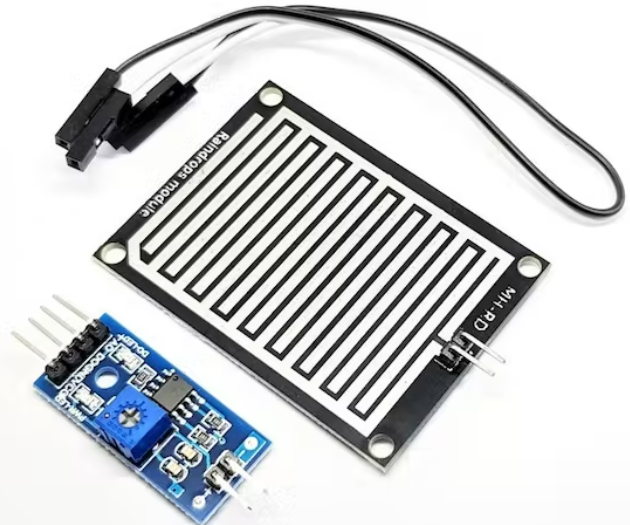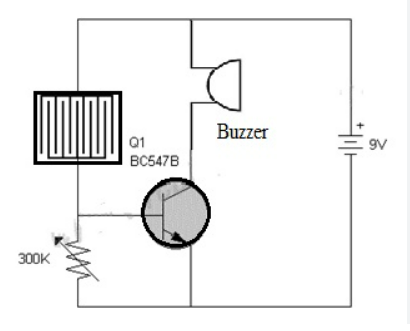2.Pertinent Information - P-Division-2022-2023-Odd/Repo05 GitHub Wiki
WHAT IS A RAIN SENSOR: WORKING & IT'S APPLICATIONS.:-
In everyone’s life, water is a basic need but conserving water as well as its proper maintenance is very important. So here is a rain sensor to detect the rain in the agriculture field & generates an alarm whenever there is rain so that we can take some proper actions to conserve the water as well as crops. Consequently, we can enhance the underground water levels through a recharge technique used underwater.This sensor detects the rain and gives an alert to concerned persons in different fields like irrigation, automobile communication, home automation, etc. This article discusses an overview of a rain sensor and its circuit working.
**WHAT IS A RAIN SENSOR:- **
A sensor that is used to notice the water drops or rainfall is known as a rain sensor. This kind of sensor works like a switch. This sensor includes two parts like sensing pad and a sensor module. Whenever rain falls on the surface of a sensing pad then the sensor module reads the data from the sensor pad to process and convert it into an analog or digital output. So the output generated by this sensor is analog (AO) and digital (DO).
SPECIFICATIONS:- The specifications of rain sensors like different parameters with values are mentioned below.
Operating voltage ranges from 3.3 to 5V
The operating current is 15 mA
The sensing pad size is 5cm x 4 cm with a nickel plate on one face.
Comparator chip is LM393
Output types are AO (Analog o/p voltage) & DO (Digital switching voltage)
The length & width of PCB module 3.2cm x 1.4cm
Sensitivity is modifiable through Trimpot
Red/Green LED lights indicators for Power & Output.
**WORKING PRINCIPLE:- **
The rain sensor working principle is pretty simple. The sensing pad includes a set of uncovered copper traces which mutually work like a variable resistor or a potentiometer. Here, the sensing pad resistance will be changed based on the amount of water falling on its surface. So, here the resistance is inversely related to the amount of water.
When the water on the sensing pad is more, the conductivity is better & gives less resistance. Similarly, when the water on the surface pad is less, the conductivity is poor & gives high resistance. So the output of this sensor mainly depends on the resistance.
RAIN SENSOR PIN CONFIGURATION..
The rain sensor is super easy to use and only has 4 pins to connect.

**ANALOG OUTPUT(AO) PIN:- **
This pin gives an analog signal between the voltage supply from 5V to 0V.
DIGITAL OUTPUT(DO) PIN:-
This pin gives digital o/p for the internal comparator circuit & it can be connected to an Arduino board otherwise to a 5V relay.
VCC PIN:-
The pin provides a voltage supply to the rain sensor that ranges from 3.3V to 5V. Here, the analog output will change based on the voltage provided to the sensor.
Rain Sensor Module
The rain sensor module includes a sensing pad which includes two series copper tracks coated with nickel. This pad includes two header pins which are connected internally to the copper tracks of the pad. The main function of these two header pins is for connecting the Sensing Pad with the rain sensor module with the help of two jumper wires. Here, the rain sensor module’s one pin provides a +5v power supply toward the one path of the sensing pad, whereas the other pin gets the return power from another path of the pad.

Generally in dry situations, this pad gives huge resistance as well as less conductive. So, the voltage supply cannot be supplied from one path to another path. Here resistance mainly depends on the quantity of water on the sensing pad surface. Once water falls on the surface of the sensor pad, then its resistance will be reduced & conductivity will be enhanced. So, once the amount of water increases on the surface of the pad then it can supply huge power from one path to other.
Sensor Module The Sensor module includes some essential components like Variable Resistor, LM393 IC, output LED & Power LED.
Variable Resistor The rain sensor module includes a variable resistor onboard. The main function of this is to fix the rain sensor’s sensitivity, turn the preset knob to change the rain detection sensitivity. If the knob is turned in clockwise, then the sensitivity of the rain sensor will beenhanced. If it is rotated anticlockwise, then the sensitivity of this sensor will be reduced.
Power LED The main function of the power LED in this module is to indicate the power supply of the sensor is ON/OFF. Once we switched ON the power supply for this sensor, then the RED LED will be switched ON.
Output LED Once the rain sensor notices the water drop or rainfall, then RED LED will be activated. Similarly, the rain is not detected by the module then RED LED will be deactivated
WORKING: At first, the sensing pad has to connect to the sensor module using a jumper wire. Now, both the pins of rain sensor modules like GND & VCC are connected to a 5V power supply pin. After that, fix the threshold voltage at the Non-Inverting terminal of the LM393 IC in the dry state of the pad by turning the knob of the potentiometer to fix the sensitivity of the rain sensor. the volume of raindrops on the surface of the pad increases then its conductivity increases & resistance decreases. After that from the pad, a less amount of voltage can be provided to the Inverting input terminal of the LM393 IC. Then this IC evaluates this voltage through the threshold voltage. In this state, the input voltage is low as compared to the threshold voltage, as a result, the output of the rain sensor goes LOW. When no rain falls on the surface of the pad then it has high resistance & less conductivity. After that, the high voltage will be assigned across the pad. Thus, the high voltage from the pad can be provided to the Inverting input of the IC. Once more the integrated circuit evaluates this voltage by using the threshold voltage. So, in this state, this input voltage is higher as compared to the threshold voltage. As a result, the output of the sensor module goes high.
RAIN SENSOR CIRCUIT:-
The rain sensor alarm circuit is shown below. This circuit can be designed with different components like rain sensor module, 9V supply, buzzer, variable resistor - 300K, BC547B transistor, etc.

In the following circuit, the BC547B transistor is an essential component that works like a switch in this circuit. The rain sensor is very responsive to water drops or rainfalls. The circuit sensitivity can be adjusted through a variable resistor. Once the rain falls onto the sensor strips then the circuit will be activated because water is a great electricity conductor. The voltage is supplied to the transistor to turn ON the transistor then it activates the buzzer which is connected to it. Here, the buzzer in this circuit works like an alarm to alert the user. For better performance, the sensor strip must be connected very close to the circuit. This sensor can be designed through different methods based on your choice & convenience.
TYPES OF RAIN SENSOR:-
There are different kinds of rain sensor are available which include the following.
WATER COLLECTION BASIN.
This kind of sensor is one of the initial types. As the name suggests, a basin or a cup is connected to this sensor to work as a rain gauge because the water gathers within it. So this will help the sensor to decide whether it requires triggering the sprinklers. The main disadvantage of this sensor is that it cannot differentiate among debris & rainwater so this can lead to an incorrect disruption of the watering cycle. Once the sensor includes a shallower basin, then the wind can drive the water away from the container that leads to related problems. These are also called collection cups of rainfall and they work through wireless systems also.
CONDUCTIVE SENSORS.
Conductive sensors utilize advanced technology & the working principle of this sensor is conductivity. In this sensor, there are mainly two electrodes present underneath the basin. Once the level of water achieves these electrodes then a circuit finishes & activates a switch. This system can distinguish between water and wastage, however, if the wastage comes up the level of water after a brief clean-up, the sprinklers may disable prematurely. Therefore, the open container is a problem in both collections of water as well as the conductive type of rain sensors.
HYGROSCOPIC DISK.
This kind of sensor has achieved so much popularity over the years & it is considered as most accurate. This sensor includes a cork disk that increases through absorbing rain. This turns ON a switch after a fixed quantity is gathered. The planned watering won’t begin except the disk has dried out and taken back to its regular size; thus the longer it stays wet &expanded, the sprinklers will stay shut down for a long time. This system has been confirmed to be efficient & accurate which has been included in its command.
FREEZE SENSORS.
Freeze sensors are mainly designed to notice rain & frost. They detect the temperature to decide once the water runs throughout the sprinkler pipes risk breaking them. These types of sensors are the most expensivE.
ADVANTAGES
The advantages of rain sensors include the following.
The rain sensor is used to save money by disabling the irrigation system once it rains. So that electricity consumption can be reduced.
Simple operating principle
It operates with less power
The cost of an individual sensor is less
Rain sensor-based systems installation is very simple
The life of different systems based on rain sensors will be extended like irrigation systems, car wipers through running them simply once it is needed.
APPLICATIONS
The applications of rain sensors include the following.
These are essential components for the automatic systems used in the agriculture field because rainfall is detected throughout the months of irrigation. These automatically disable the irrigation system while receiving a preferred amount of rainfall & allow this system to restart its fixed conditions once the sensor module gets dried. Please refer to this link to know more about Temperature Sensor & Gyroscope Sensor. Please refer to this link to know more about Face Recognition MCQs. Thus, this is all about an overview of a rain sensor. A rain sensor alarm circuit is an extremely helpful device to alert the user by generating a buzzer sound once rain or waterfalls on the strip. It is used in different areas where the operator needs to be aware of water drops or rainfalls. Here is a question for you, what are the disadvantages of rain sensors.
SOURCE: